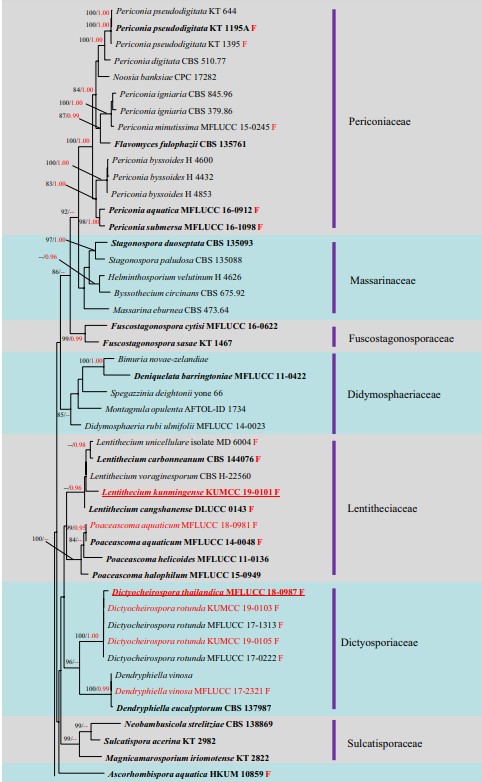Aquatospora W. Dong, H. Zhang & K.D. Hyde, in Dong et al., Fungal Diversity: 10.1007/s13225-020-00463-5, [59] (2020)
Index Fungorum number: IF557903; Facesoffungi number: FoF09245
Etymology: referring to aquatic habitat of this fungus Saprobic on decaying wood submerged in freshwater.
Sexual morph: Ascomata black, scattered or gregarious, superficial, hemisphaerical to conical, base flattened, carbonaceous, with ostiolate papilla. Ostiole central, relatively broad, circular, black. Peridium uneven in width, carbonized, composed of a black amorphous layer, whose cells are obscured. Pseudoparaphyses numerous, trabeculate, filiform, hyaline, sparsely septate. Asci 8-spored, bitunicate, clavate to narrowly ellipsoidal, with a short pedicel, apically rounded. Ascospores 2–4-seriate, hyaline, septate, subcylindrical, thin-walled, smooth.
Asexual morph: Undetermined.
Type species: Aquatospora cylindrica W. Dong, H. Zhang & K.D. Hyde
Notes: – Aquatospora clusters with Acrocordiopsis Borse & K.D. Hyde and Xenoastrosphaeriella Jayasiri et al. with low bootstrap support (Fig. 2). Acrocordiopsis is a problematic genus, which was placed in Salsugineaceae by Hyde et al. (2013) and Caryosporaceae by Ariyawansa et al. (2015). Acrocordiopsis was referred to Salsugineaceae (Wijayawardene et al. 2018, 2020) based on some common morphology between Acrocordiopsis and Salsuginea K.D. Hyde (Borse and Hyde 1989; Hyde 1991). Acrocordiopsis clustered distantly from Salsuginea in the phylogenetic tree of Zhang et al. (2018) and close to Aquatospora in our study (Fig. 2). Xenoastrosphaeriella differs from Aquatospora in having paler end cells of ascospores (Hawksworth and Boise 1985; Phookamsak et al. 2015b; Jayasiri et al. 2019). Aquatospora shares similar characters with Astrosphaeriellaceae members in having large, erumpent to superficial, hemisphaerical or conical, carbonaceous ascomata with nearly flattened bases (Borse and Hyde 1989; Ariyawansa et al. 2015; Phookamsak et al. 2015b). However, the unique combination of the morphology of clavate to narrowly ellipsoidal asci, hyaline, cylindrical ascospores and molecular characters warrant Aquatospora as a new genus.

Fig. 2 Phylogram generated from maximum likelihood analysis of combined LSU, ITS, TEF and RPB2 sequence data for species of Dothideo- mycetes. Bootstrap values for maximum likelihood equal to or greater than 75% and Bayesian posterior probabilities equal to or greater than 0.95 are placed near the branches as ML/BYPP. Newly generated sequences are in red and ex-type strains are in bold. The new species intro- duced in this study are indicated with underline. Freshwater strains are indicated with a red letter “F”. Orders not treated in this study are compressed. The tree is rooted to Capronia pilo- sella AFTOL-ID 657 and Endo- carpon pallidulum AFTOL-ID 661 (Eurotiomycetes)
Species
